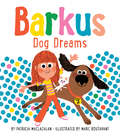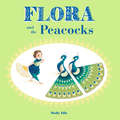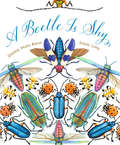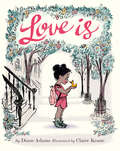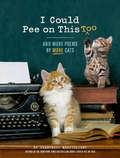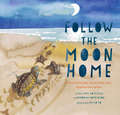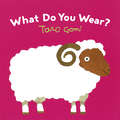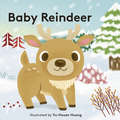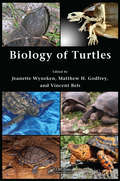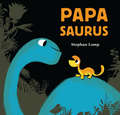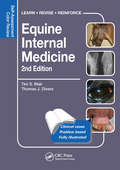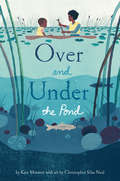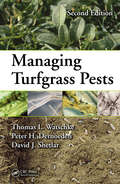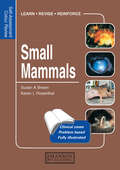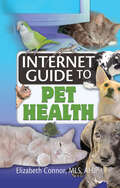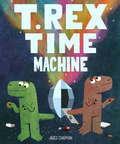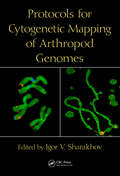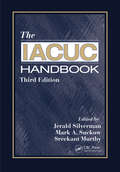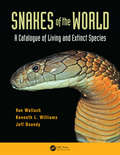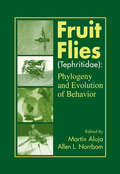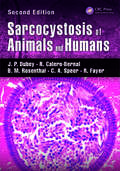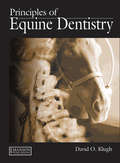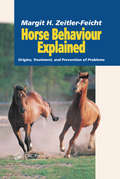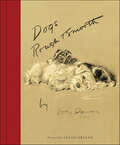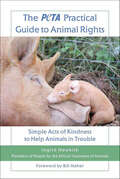- Table View
- List View
Barkus Dog Dreams: Book 2 (Barkus #2)
by Patricia MacLachlanBarkus is back! With new tricks. New friends. And lots more fun. The lovable Barkus and his lucky young owner romp through the pages of this delightful series from Newbery Medal–winning author Patricia MacLachlan. The simple text told in short chapters is just right for children ready to take their first steps toward reading on their own.
Flora and the Peacocks
by Molly IdleThe darling, dancing Flora is back, and this time she's found two new friends: a pair of peacocks! But amidst the fanning feathers and mirrored movements, Flora realizes that the push and pull between three friends can be a delicate dance. Will this trio find a way to get back in step? In the third book featuring Flora and her feathered friends, Molly Idle's gorgeous art combines with clever flaps to reveal that no matter the challenges, true friends will always find a way to dance, leap, and soar—together.
A Beetle Is Shy
by Dianna Hutts AstonThe award-winning duo of Dianna Hutts Aston and Sylvia Long team up again, this time creating a gorgeous look at the fascinating world of beetles. From flea beetles to bombardier beetles, an incredible variety of these beloved bugs are showcased here in all their splendor. Poetic in voice and elegant in design, this carefully researched and visually striking book is perfect for sparking children's imaginations in both classroom reading circles and home libraries. Plus, this is the fixed-format version, which looks almost identical to the print edition!
Love Is: (illustrated Story Book About Caring For Others, Book About Love For Parents And Children, Rhyming Picture Book)
by Diane AdamsPerfect for any fond gift or tender moment, this story of a girl and a duckling who share a touching year together will melt hearts old and young. In this tenderly funny book, girl and duckling grow in their understanding of what it is to care for each other, discovering that love is as much about letting go as it is about holding tight. Children and parents together will adore this fond exploration of growing up while learning about the joys of love offered and love returned.
I Could Pee on This, Too: And More Poems by More Cats
by Francesco MarciulianoThere's a new cat in town! This feisty sibling of the international bestseller I Could Pee on This will be making its own sensational mark in the cat-poetry world. I Could Pee on This, Too explores fresh feline emotions and philosophical musings through cats' own poetry, such as "Welcome New Cat," "Sleeping My Life Away," and "You Also Live Here." Any cat lover who's longed for a deeper look into the enigmatic world of their cats will fall whiskers over paws for this well-versed follow-up.
Follow the Moon Home: A Tale of One Idea, Twenty Kids, and a Hundred Sea Turtles
by Deborah Hopkinson Philippe CousteauAcclaimed activist Philippe Cousteau and renowned author Deborah Hopkinson team up to offer a story of the powerful difference young people can make in the world. Meet Viv, who has a new home and a new school by the sea, and follow her as she finds her way in a new place and helps bring together a whole community to save the sea turtles of the South Carolina coast. Plus, this is the fixed format version, which looks almost identical to the print edition.
What Do You Wear?
by Taro GomiWhen it comes to getting toddlers dressed, the struggle is real. Enter: Taro Gomi! The bestselling author/illustrator offers a creative and colorful look at animals, reimagining their fur, feathers, and fins as...clothes! A sheep wears a fluffy jacket, a zebra sports striped PJs, a snake is snug in a stocking, and a penguin looks dapper in a classic suit. Young children will be amused by the spirited take on animals, and they'll very likely be convinced that getting dressed is best!
Baby Reindeer
by Yu-hsuan HuangMeet Baby Reindeer! How does Baby Reindeer stay warm in the frosty weather? What yummy meal does Baby Reindeer find hidden beneath the snow? Follow along as he experiences his world, from playtime to bedtime. Warm illustrations plus a comforting story about the rhythms of a baby reindeer’s day make this perfect for the very youngest readers.
Biology of Turtles: From Structures to Strategies of Life
by Vincent Bels Jeanette Wyneken Matthew H. GodfreyFeaturing in-depth contributions from an international team of experts, the Biology of Turtles provides the first comprehensive review of the Testudinata. The book starts with the premise that the structure of turtles is particularly interesting and best understood within the context of their development, novelty, functional diversity, and e
Papasaurus
by Stephan LompBabysaurus loves playing hide-and-seek with his Papasaurus. But one day, no matter where he looks, he can't find him, so Babysaurus turns to his prehistoric friends for help. Where can his Papasaurus be? Of course, Papasaurus has been right there all along, and when Babysaurus needs a little help, Papasaurus is ready with a big kiss and more games. This colorful and reassuring book is a fresh twist on a perennial theme that will win the hearts of little ones and their papas alike.
Equine Internal Medicine: Self-Assessment Color Review Second Edition (Veterinary Self-Assessment Color Review Series)
by Tim S. Mair Thomas J. DiversWritten by well-respected experts from the UK and USA, Equine Internal Medicine: Self-Assessment Color Review Second Edition presents more than 200 interesting and challenging cases encountered in equine practice, complete with photographs, imaging, or endoscopy findings; blood or fluid smears; other ancillary tests; and, in some cases, pathologic
Over and Under the Pond
by Kate MessnerIn this gorgeous companion to the acclaimed Over and Under the Snow and Up in the Garden and Down in the Dirt, Kate Messner and Christopher Silas Neal bring to life a secret underwater world. In this book, readers will discover the plants and animals that make up the rich, interconnected ecosystem of a mountain pond. Over the pond, the water is a mirror, reflecting the sky. But under the pond is a hidden world of minnows darting, beavers diving, tadpoles growing. These and many other secrets are waiting to be discovered...over and under the pond.
Managing Turfgrass Pests
by Thomas L. Watschke Peter H. Dernoeden David J. ShetlarWritten by three of the top professionals in the turfgrass field, Managing Turfgrass Pests, Second Edition brings together hundreds of solutions and best practices to help you manage turfgrass weeds, diseases, and insects more effectively. Since the publication of the bestselling first edition, advances in pest-resistant turfgrass cultivars and pes
Small Mammals: Self-Assessment Color Review (Veterinary Self-Assessment Color Review Series)
by Susan A. Brown Karen L. RosenthalVeterinary practitioners are faced regularly by diseases and disorders in a large and ever increasing range of small mammalian patients. The Editors have gathered together contributions from 29 experts, who cover all aspects of medicine and surgery in small mammals including rabbits, guinea pigs, rodents, hedgehogs, ferrets, primates, squirrels, fo
Internet Guide to Pet Health
by Elizabeth ConnorWith the staggering amount of pet health information available on the Internet, it is often difficult to find exactly what you are looking for. The Internet Guide to Pet Health is a one-stop guide that weeds through all the clutter to bring you only the most dependable sources and relevant content. This comprehensive compilation of annotated links will serve as a handy, useful, and easy-to-consult guide for persons who appreciate animals and/or own domestic pets of all kinds, especially cats and dogs. This text also features a full glossary of medical terms, bibliography, and a quick-find index.The health needs of pet animals have become as complex and specialized as those of humans. Pet owners, veterinarians, and animal lovers alike need authoritative, reliable, and up-to-date information about caring for the health and well-being of pets. The Internet Guide to Pet Health offers a quick, easy, and comprehensive reference to quality Web sites that focus on the health and welfare of animal companions. The Internet Guide to Pet Health will help you pinpoint reliable information on: • the health benefits of pet ownership • diseases transmitted by pets • pet food safety • animal care and welfare societies and organizations • death, dying, and euthanasia • poisons, dangerous situations, and other hazards • spaying and neutering • traveling with pets • pet-specific care for dogs, cats, small animals, and fish • surgery, surgical procedures, and hospitalization • exercise and training • dental care, diet, and nutrition • disabled pets • service and therapy animals • and much, much more! The Internet Guide to Pet Health is an ideal resource for anyone who is directly involved in the lives of pet companions or simply an animal lover. Medical librarians in academic medical centers and teaching hospitals; consumer health and public librarians; veterinarians and veterinary clinic staff; public health personnel; animal trainers; and groomers will also find this to be an invaluable text.
T. Rex Time Machine (T. Rex Time Machine)
by Jared Chapman"Hilarious!" —Pragmatic Mom"Certain to keep parents and kids alike giggling." —Booking MamaWhen two hungry dinosaurs jump into a time machine, they're transported to an unbelievable, magical, surreal future: RIGHT HERE, RIGHT NOW! On the T. Rexes' madcap voyage into the unknown, they encounter the many wonders of the modern world: Police cars! Phones! Microwaves! They don't know how they'll get home—but why would they want to? Acclaimed author and illustrator Jared Chapman combines two favorite kid topics—time travel and dinosaurs—with bold colors, big jokes, and a hilarious escapade. This raucous, laugh-out-loud adventure will delight the very young and keep older readers giggling long into the future.
Protocols for Cytogenetic Mapping of Arthropod Genomes
by Igor V. SharakhovArthropods are important to worldwide agriculture, food safety, human health, and energy production. Besides their practical significance, various species represent excellent model systems for biological investigations of evolution, development, physiology, reproduction, and social interaction. For these reasons, arthropod genomics is receiving inc
The IACUC Handbook
by Jerald Silverman Mark A. Suckow Sreekant MurthyEver since its establishment by USDA regulation in the mid-1980s, the Institutional Animal Care and Use Committee (IACUC) has evolved as the premier instrument of animal welfare oversight within research institutions in the United States. As biomedical research continuously grows, the role and impact of the IACUC has increased in scope and complexity. The IACUC Handbook has become "the Bible" for individuals when the time comes for them to serve on their institution’s IACUC. It provides a foundation for understanding and implementing the many and varied responsibilities of this committee.This Third Edition comprehensively addresses the significant changes in the pertinent regulatory environment and interpretation of applicable federal laws, regulations, and policies. It provides multiple references and commentary on the new edition of the Guide for the Care and Use of Laboratory Animals, the new AVMA Guidelines for the Euthanasia of Animals: 2013 Edition, and the Office of Laboratory Animal Welfare’s Frequently Asked Questions. The Third Edition also features an updated survey of IACUC practices from institutions around the United States, offering wisdom gained from their experience. In addition, it includes a chapter that provides an international perspective on how animal welfare reviews can function in other countries.
Snakes of the World: A Catalogue of Living and Extinct Species
by Van Wallach Kenneth L. Williams Jeff BoundySnakes of the World: A Catalogue of Living and Extinct Species-the first catalogue of its kind-covers all living and fossil snakes described between 1758 and 2012, comprising 3,509 living and 274 extinct species allocated to 539 living and 112 extinct genera. Also included are 54 genera and 302 species that are dubious or invalid, resulting in reco
Fruit Flies (Tephritidae): Phylogeny and Evolution of Behavior
by Martín Aluja Allen L. NorrbomFruit flies (Diptera: Tephritidae) are among the most destructive agricultural pests in the world, eating their way through acres and acres of citrus and other fruits at an alarming rate and forcing food and agriculture agencies to spend millions of dollars in control and management measures. But until now, the study of fruit flies has been traditi
Sarcocystosis of Animals and Humans
by J. P. Dubey R. Calero-Bernal B.M. Rosenthal C.A. Speer R. FayerSarcocystis is one of the most prevalent parasites of livestock and also infects many wild mammals, birds, and humans. Written by the authors who pioneered studies of Sarcocystosis of domestic animals, Sarcocystosis of Animals and Humans, Second Edition provides a current and comprehensive review of Sarcocystis and the infections it causes in anima
Principles of Equine Dentistry
by David O KlughThe equine dentition (hypsodont) develops differently from that of humans and small animals (brachydont) yet many of the principles of general dentistry are applicable to the equine species. Some are not.Dr Klugh and his contributing authors identify, apply and evaluate the principles of equine dentistry in relation to the horse-their similarities
Horse Behaviour Explained: Origins, Treatment and Prevention of Problems
by Margit Zeitler-FeichtThis book is a general guide to understanding horse behavior, how the horse learns and how horse handlers can adjust their behavior to avoid creating anxiety in the horse. The author begins by providing an overview of the evolution of the horse and the consequences of domestication. She goes on to provide a very detailed description of normal equin
Dogs Rough and Smooth: Foreword By Susan Orlean
by Lucy DawsonForeword by Susan OrleanA charming facsimile edition of celebrated British illustrator Lucy Dawson’s 1937 classic collection of highly detailed and loveable drawings of dogs, complete with a cloth spine and ribbon marker—the companion volume to the acclaimed Dogs As I See Them.Lucy Dawson, also known as "Mac," was a preeminent British illustrator in the 1930s and 1940s revered for her paintings and etchings of dogs, from sporting and non-sporting breeds to hounds and herders. Though she worked in numerous mediums—pencil, pen, ink, and oil—her pastels set her work apart. Noted for her commercial dog postcards and her delightful "Tailwagger" series, she also created a "Puppies" series of 40 cigarette cards during World War II—produced in a limited quantity due to wartime restrictions on paper—which have become a rare collector’s item today. One of her most famous works is her portrait of "Dookie," the British Royal Family’s favorite Corgie, which was later reproduced as a Royal Family Christmas card.Dawson also published several books, including the beloved Dogs As I See Them, and its follow-up, Dogs Rough and Smooth. Now, Dogs Rough and Smooth is available in a lovely facsimile edition for a new generation discovering her superb craftsmanship. Printed on an uncoated stock that simulates the look and feel of a sketchbook, this delightful volume is filled with her beautiful, endearing drawings of a range of breeds. The illustrations are accompanied by notes in Dawson’s own handwriting as well as a short anecdotal text that provides amusing insight into the personalities of her canine models and the experience of drawing each.A stunning reproduction of this classic work filled with full-color and black-and-white complete drawings and sketches, Dogs Rough and Smooth features a foreword by acclaimed writer Susan Orlean, and is packaged in a three-piece case with a beautiful cloth spine and long ribbon bookmark. Dogs Rough and Smooth is sure to be a collector's item treasured by dog lovers of all ages and art connoisseurs for years to come.
The PETA Practical Guide to Animal Rights: Simple Acts of Kindness to Help Animals in Trouble
by Ingrid NewkirkWith more than two million members and supporters, People for the Ethical Treatment of Animals (PETA) is the world's largest animal-rights organization, and its founder and president, Ingrid Newkirk, is one of the most well-known and most effective activists in America. She has spearheaded worldwide efforts to improve the treatment of animals in manufacturing, entertainment, and elsewhere. Every day, in laboratories, food factories, and other industries, animals by the millions are subjected to inhumane cruelty. In this accessible guide, Newkirk teaches readers hundreds of simple ways to stop thoughtless animal cruelty and make positive choices. For each topic, Newkirk provides hard facts, personal insight, inspiration, ideas, and resources, including: • How to eat healthfully and compassionately • How to adopt animals rather than support puppy mills • How to make their vote count and change public opinion • How to switch to cruelty-free cosmetics and clothing • How to choose amusements that protect rather than exploit animals. With public concern for the well-being of animals greater than ever—particularly among young people—this timely, practical book offers exciting and easy ways to make a difference.
